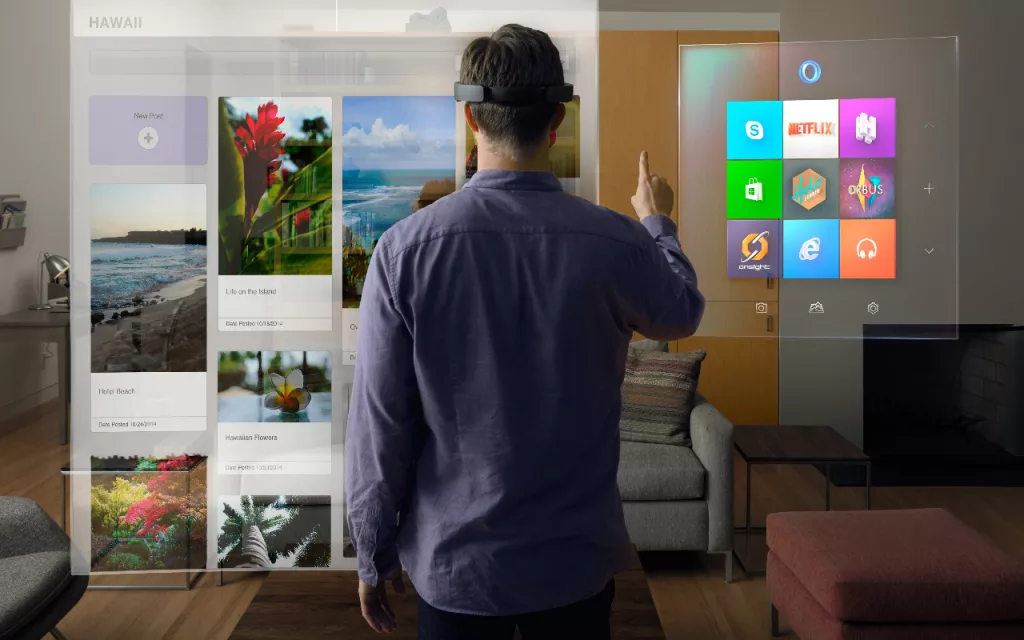Is Augmented Reality Dead? Exploring the Current State

Augmented reality (AR) has been a buzzword for several years now, with tech giants like Google, Microsoft, and Apple investing heavily in the technology. However, with the hype around AR seemingly dying down, many are questioning whether the technology is dead as well.
While AR has not yet reached the level of adoption that was once predicted, it is far from dead. In fact, the technology is still being developed and improved upon, and there are several industries where AR is being used to great effect. For example, in the healthcare industry, AR is being used for surgical training and medical education, while in the retail industry, AR is being used to enhance the shopping experience for customers.
Despite the slow adoption of AR, there are still many potential use cases for the technology, and as the technology continues to improve, it is likely that we will see more and more applications of AR in various industries. While it may not have lived up to the hype that surrounded it a few years ago, it is clear that augmented reality is still very much alive and has a bright future ahead of it.
Understanding Augmented Reality
Definition and Functionality
Augmented Reality (AR) is a technology that overlays digital information on top of the physical environment. It is designed to enhance the user’s perception of reality by adding computer-generated information to the real world. AR is different from Virtual Reality (VR), which creates a completely immersive digital environment.
AR works by using a camera or other sensors to capture the real world, and then adding digital information to it. This digital information can take many forms, such as images, videos, or 3D models. The digital information is then displayed to the user through a device such as a smartphone, tablet, or AR headset.
AR can be used in a wide range of applications, from gaming and entertainment to education and training. It can also be used in industrial and commercial settings to enhance productivity and safety.
Current Applications and Uses
AR is currently being used in a variety of applications and industries. In the entertainment industry, AR is being used to create interactive experiences for movies, television shows, and video games. For example, the popular game Pokémon Go uses AR to allow players to catch digital creatures in the real world.
In the retail industry, AR is being used to create virtual try-on experiences for clothing and makeup. This allows customers to see how a product will look on them before making a purchase.
AR is also being used in education and training. For example, medical students can use AR to practice surgical procedures on virtual patients. AR can also be used to create interactive learning experiences for students of all ages.
In industrial and commercial settings, AR is being used to enhance productivity and safety. For example, workers in a factory can use AR to see digital instructions overlaid on the physical equipment they are working on. This can help reduce errors and increase efficiency.
Overall, AR is a versatile technology with many applications and uses. As the technology continues to evolve, it is likely that we will see even more innovative uses for AR in the future.
Arguments for Augmented Reality’s Decline
Technical Limitations
One of the main arguments against augmented reality’s future success is its technical limitations. The technology required to create a seamless augmented reality experience is still in its infancy. The hardware required to run AR applications is often bulky and expensive, making it inaccessible to the average consumer. Additionally, AR technology is still not advanced enough to create a truly immersive experience. The current state of AR is often glitchy and unreliable, which can lead to a frustrating user experience. Until these technical limitations are addressed, it is unlikely that augmented reality will become a mainstream technology.
Market Saturation
Another argument against the success of augmented reality is market saturation. There are already several established technologies that compete with AR, such as virtual reality and smartphones. Virtual reality offers a more immersive experience than AR, while smartphones provide a more convenient way to access digital content. With so many established technologies already available, it may be difficult for AR to gain a significant market share.
Consumer Disinterest
Finally, there is the argument that consumers simply aren’t interested in augmented reality. Despite the hype surrounding AR, many consumers may not see the value in the technology. AR applications are often seen as gimmicky and unnecessary, and many consumers may not be willing to invest in AR hardware. Without consumer interest, it is unlikely that augmented reality will become a mainstream technology.
Overall, there are several arguments that suggest that augmented reality may not have a bright future. Technical limitations, market saturation, and consumer disinterest are all factors that could prevent AR from becoming a mainstream technology. However, it is important to note that these are just potential obstacles, and it is possible that AR could still overcome them and become a successful technology in the future.
Counterarguments for Augmented Reality’s Relevance
Despite the criticisms and doubts surrounding the future of Augmented Reality (AR), there are still counterarguments that support its relevance. This section will explore some of the counterarguments, including technological advancements, emerging markets, and innovative uses.
Technological Advancements
One of the primary arguments for the relevance of AR is the continuous technological advancements in the field. With the advent of 5G networks, AR can now be used on mobile devices to provide seamless experiences. This technology can enable AR to be used in various industries, including healthcare, education, and entertainment.
Moreover, the development of AR glasses and headsets has improved the user experience by providing a hands-free and immersive experience. The AR glasses can be used in various fields, including manufacturing, logistics, and retail. For instance, AR glasses can be used to scan barcodes, identify products, and provide real-time information to the user.
Emerging Markets
Another argument for the relevance of AR is the emerging markets that are adopting the technology. The Asia-Pacific region is one of the fastest-growing markets for AR. The region has a large population and a growing middle class, which creates a significant market for AR products and services.
Moreover, the use of AR in the automotive industry is also growing. AR can be used to provide real-time information to drivers, such as speed, direction, and traffic conditions. This technology can also be used to provide a more immersive experience for passengers, such as virtual tours and games.
Innovative Uses
Lastly, the innovative uses of AR are another argument for its relevance. AR can be used in various industries, including healthcare, education, and entertainment. For instance, AR can be used in healthcare to provide real-time information to doctors and nurses, such as patient data, medical images, and treatment plans.
Moreover, AR can be used in education to provide immersive experiences for students. For example, AR can be used to provide virtual tours of historical sites and museums. This technology can also be used to provide interactive learning experiences, such as science experiments and simulations.
In conclusion, despite the criticisms and doubts surrounding the future of AR, there are still counterarguments that support its relevance. Technological advancements, emerging markets, and innovative uses are some of the reasons why AR is still a relevant technology.
Case Studies of Successful Augmented Reality Applications
Despite concerns about the decline of augmented reality (AR) technology, there are still many successful AR applications in use today. These applications have proven to be useful and practical in a variety of settings, from education to healthcare to entertainment.
One notable example of a successful AR application is the Ikea Place app. This app allows users to visualize furniture in their own homes using AR technology. By simply pointing their phone’s camera at a space, users can see how different pieces of furniture would look in that space. This technology has revolutionized the furniture shopping experience, allowing users to make more informed decisions about their purchases.
Another successful AR application is the Pokemon Go game. Released in 2016, Pokemon Go quickly became a global phenomenon, with millions of users playing the game daily. The game uses AR technology to allow users to catch virtual Pokemon in the real world. This game has been praised for its ability to get users outside and active, as well as for its innovative use of AR technology.
AR technology has also been used successfully in the healthcare industry. For example, the AccuVein app uses AR to help healthcare professionals locate veins in patients. By projecting an image of the veins onto the patient’s skin, healthcare professionals can more easily and accurately locate veins for blood draws and other medical procedures.
In the education sector, AR technology has been used to enhance learning experiences. For example, the Anatomy 4D app allows users to explore the human body in 3D using AR technology. This app has been used in classrooms to help students better understand human anatomy and physiology.
Overall, these successful AR applications demonstrate the continued relevance and usefulness of AR technology. While there may be concerns about the decline of AR, these case studies show that there is still a place for AR in a variety of industries and settings.
Future Predictions for Augmented Reality
Despite some critics claiming that augmented reality (AR) is dead, many experts predict a bright future for this technology. According to a report by BCG and Mordor Intelligence, the current market value for AR/VR/MR is around $30.7 billion, and the market size worldwide of the AR/VR/MR market is expected to rise to $300 billion by 2024. This indicates that AR is still a growing market with a lot of potential.
One of the key areas where AR is expected to make a significant impact is in the retail industry. With the rise of e-commerce, retailers are looking for new ways to engage with customers and provide a more immersive shopping experience. AR technology can allow customers to try on clothes virtually, see how furniture would look in their home, or even test out makeup without having to physically be in the store. This can lead to increased sales and customer satisfaction.
Another area where AR is expected to have a significant impact is in education and training. AR can provide a more interactive and engaging learning experience, allowing students to visualize complex concepts in a more tangible way. AR can also be used in training programs to simulate real-world scenarios, allowing employees to practice and improve their skills in a safe and controlled environment.
AR is also expected to play a significant role in the development of smart cities. By overlaying digital information onto the physical world, AR can provide real-time information about traffic, public transportation, and other city services. This can help improve efficiency and reduce congestion, making cities more livable for residents.
Overall, while some may argue that AR is dead, the evidence suggests otherwise. AR is still a growing market with a lot of potential, and experts predict that it will continue to play a significant role in various industries in the future.
Conclusion
In conclusion, it is clear that augmented reality (AR) is not dead. While there may have been a lull in the hype surrounding AR, the technology has continued to evolve and find its place in various sectors, including entertainment, gaming, healthcare, and retail.
According to an article by ARise Vision, advancements in mobile technology and the rise of AR-specific hardware have contributed to the growth and potential of AR in the global tech landscape. Additionally, a literature article by the Interaction Design Foundation notes that AR has been used to enhance real-world experiences by overlaying computer-generated input, such as sound, video, graphics, and GPS overlays.
Despite the challenges faced by the industry, businesses continue to find innovative use cases for AR. For example, the Computerworld article notes that virtual and augmented reality, as well as browser-based 3D environments, may prove to be precursors to a more immersive metaverse.
Furthermore, a study published in the National Library of Medicine concludes that AR has the potential to improve patient outcomes in healthcare by providing real-time information to clinicians and enhancing patient education and engagement.
In summary, while the hype surrounding AR may have died down, the technology continues to evolve and find practical applications in various sectors. As such, it is safe to say that augmented reality is not dead, but instead is continuing to grow and evolve.







